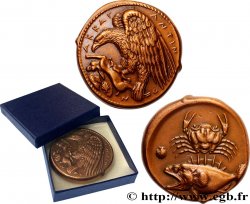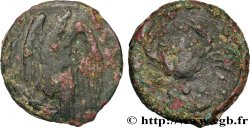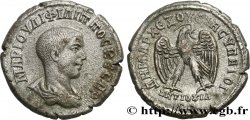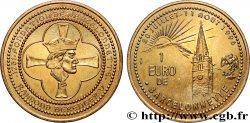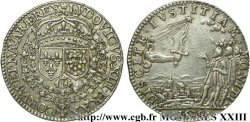v47_0022 - SICILIA - AGRIGENTUM Tétradrachme
MONNAIES 47 (2011)
Prezzo di inizio : 18 000.00 €
Valutazione : 25 000.00 €
lotto invenduto
Prezzo di inizio : 18 000.00 €
Valutazione : 25 000.00 €
lotto invenduto
Tipo : Tétradrachme
Data: c. 409-406 AC.
Nome della officina / città: Sicile, Agrigente
Metallo : argento
Diametro : 26 mm
Asse di coniazione : 1 h.
Peso : 17,26 g.
Grado di rarità : R3
Commenti sullo stato di conservazione:
Exemplaire sur un flan large, éclaté à 6 heures au droit. Quadrige fantastique où tous les détails du quadrige sont bien visibles. Revers fantastique à l’usure superficielle sur le haut des plumes des aigles. Le tétradrachme semble s’animer de chaque côté. Jolie patine de collection ancienne avec des reflets dorés
N° nelle opere di riferimento :
ANS.- - MIAMG.3770 (R5) (25000€) - P.- - Jameson511 - Cop. - Delepierre- - B. traité- - Dewing564 - GC.-
Diritto
Titolatura diritto : LÉGENDE À L’EXERGUE.
Descrittivo diritto : Quadrige galopant à gauche conduit par Niké, les ailes déployées, tenant le kentron de la main droite et les rênes de la main gauche ; au-dessus du kentron, une grappe de raisin suspendue à un sarment et une branche de Sélinon ; grènetis circulaire.
Legenda diritto : AKRAGANTI/NON
Traduzione diritto : (des Akragantins).
Rovescio
Descrittivo rovescio : Deux aigles debout à gauche ; celui du premier plan, la tête relevée ; le second, les ailes déployées debout sur un lièvre mort retourné ; au-dessous du lièvre, des coquillages ; derrière, une petite tête cornue de dieu rivière tournée à droite ; le tout dans un cercle creux.
Legenda rovescio : STRATWN
Traduzione rovescio : (Straton).
Commento
Mêmes coins que l’exemplaire de la collection Jameson (p. 112-113, n° 511, pl. XXV) et que l’exemplaire de la collection Ludwig, p. 84, n°261 reproduit dans la collection Franke-Hirmer (pl. 64, n° 180) et que celui de la collection Dewing (ACNAC 6, p. 37, pl. 27, n° 564, provenant de la vente Ars Classica XVII, 3 octobre 1934, n° 127, collection Pennisi). Cet exemplaire malgré son défaut de flan est tout à fait exceptionnel de par son style et de par sa conservation. De chaque côté, une scène semble s’animer. Au droit, le quadrige s’apprête à sortir du flan tandis que la grappe de raisin et la feuille de Sélinon se détachent au premier plan. Au revers, les aigles semblent tout deux animés, déchiquetant le lièvre mort, les ailes semblent battre et fendre le vent. On perçoit presque le cri strident de l’animal victorieux qui dépèce sa victime. Au revers derrière la scène, on remarque la petite tête d’un dieu rivière, l’Hypsas qui coulait aux pieds de la cité akragantine. Sur ce type, Charles Seltman dans son article du Numismatic Chronicle voulait voir la main de Kimon, seule capable de rendre le mouvement, la grâce et la beauté de l’ensemble. Comme sur les monnaies d’or (dilitron) avec Silanos, le nom de Straton ne doit pas être interprété comme celui d’un graveur, mais plutôt comme celui d’un magistrat monétaire. Souvent ces tétradrachmes sont surfrappés sur d’autres pièces comme celui de la collection Dewing surfrappé sur une monnaie de Syracuse.
Same corners as the example in the Jameson collection (p. 112-113, no. 511, pl. XXV) and that the example from the Ludwig collection, p. 84, n°261 reproduced in the Franke-Hirmer collection (pl. 64, n° 180) and that of the Dewing collection (ACNAC 6, p. 37, pl. 27, no. 564, from the Ars Classica XVII sale, October 3, 1934, no. 127, Pennisi collection). This example, despite its lack of flan, is quite exceptional in its style and its preservation.. On each side, a scene seems to come to life. On the right, the quadriga is about to emerge from the flank while the bunch of grapes and the Selinon leaf stand out in the foreground. On the reverse, the eagles both appear animated, tearing apart the dead hare, their wings seeming to beat and cleave the wind.. We can almost hear the shrill cry of the victorious animal as it dismembers its victim.. On the reverse side behind the scene, we notice the small head of a river god, the Hypsas which flowed at the feet of the Akragantine city. On this type, Charles Seltman in his article in the Numismatic Chronicle wanted to see the hand of Kimon, alone capable of rendering the movement, the grace and the beauty of the whole. As on the gold coins (dilitron) with Silanos, the name of Straton should not be interpreted as that of an engraver, but rather as that of a monetary magistrate. Often these tetradrachms are overstruck on other coins like the one in the Dewing collection overstruck on a Syracuse coin
Same corners as the example in the Jameson collection (p. 112-113, no. 511, pl. XXV) and that the example from the Ludwig collection, p. 84, n°261 reproduced in the Franke-Hirmer collection (pl. 64, n° 180) and that of the Dewing collection (ACNAC 6, p. 37, pl. 27, no. 564, from the Ars Classica XVII sale, October 3, 1934, no. 127, Pennisi collection). This example, despite its lack of flan, is quite exceptional in its style and its preservation.. On each side, a scene seems to come to life. On the right, the quadriga is about to emerge from the flank while the bunch of grapes and the Selinon leaf stand out in the foreground. On the reverse, the eagles both appear animated, tearing apart the dead hare, their wings seeming to beat and cleave the wind.. We can almost hear the shrill cry of the victorious animal as it dismembers its victim.. On the reverse side behind the scene, we notice the small head of a river god, the Hypsas which flowed at the feet of the Akragantine city. On this type, Charles Seltman in his article in the Numismatic Chronicle wanted to see the hand of Kimon, alone capable of rendering the movement, the grace and the beauty of the whole. As on the gold coins (dilitron) with Silanos, the name of Straton should not be interpreted as that of an engraver, but rather as that of a monetary magistrate. Often these tetradrachms are overstruck on other coins like the one in the Dewing collection overstruck on a Syracuse coin







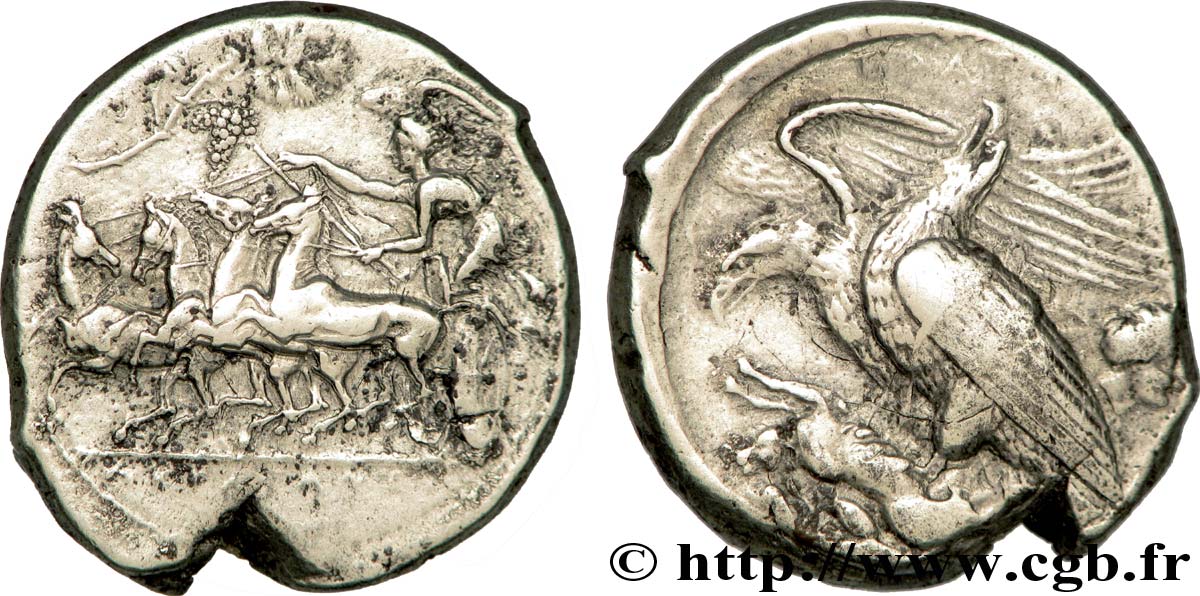
 Segnalare un errore
Segnalare un errore Stampate la pagina
Stampate la pagina Condividi mia selezione
Condividi mia selezione Fai una domanda
Fai una domanda Consegnare / vendere
Consegnare / vendere
 Descrittivo
Descrittivo